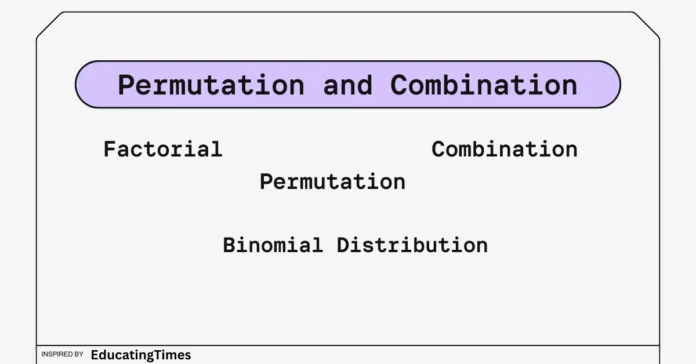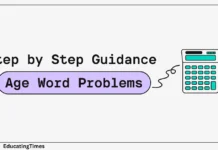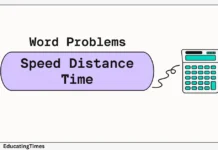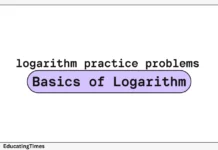Permutation and Combination
| Concept | Formula | Explanation |
|---|---|---|
| Permutation (without repetition) | P(n, r) = n! / (n – r)! | Calculates the number of ways to arrange r items from a set of n items, without repetition. |
| Permutation (with repetition) | P(n1, r1) * P(n2, r2) * … * P(nk, rk) | Calculates the number of ways to arrange items with repetitions, where n1, n2, …, nk are the number of distinct items and r1, r2, …, rk are the number of times each item can be repeated. |
| Combination (without repetition) | C(n, r) = n! / (r! * (n – r)!) | Determines the number of ways to select r items from a set of n items, without considering the order. |
| Combination (with repetition) | C(n + r – 1, r) = (n + r – 1)! / (r! * (n – 1)!) | Computes the number of ways to select r items from a set of n items, allowing repetitions. |
Factorial
Q1: Simplify 6!
Solution:
We can use the definition of factorial to simplify
6!:
6! = 6 x 5 x 4 x 3 x 2 x 1 = 720
b) Evaluate 9!/7!
We can simplify 9!/7! by dividing 9! by 7!
9!/7! = 9 x 8 x 7 x 6 x 5 x 4 x 3 x 2 x 1 / (7 x 6 x 5 x 4 x 3 x 2 x 1) = 9 x 8 = 72
c) Evaluate 0!
By definition, 0! is equal to 1.
Therefore, 0! equals 1.
Permutation
Q1
a) How many different 4-digit numbers can be formed using the digits 1, 2, 3, and 4 without repeating any digit?
Solution: Since order matters in this case, we need to use the permutation formula:
P(4,4) = 4! = 24
Therefore, there are 24 different 4-digit numbers that can be formed using the digits 1, 2, 3, and 4 without repeating any digit.
b) A race has 5 runners. In how many ways can they finish first, second, and third?
Solution: Again, order matters in this case, so we can use the permutation formula:
P(5,3) = 5! / (5-3)! = 60
Therefore, there are 60 ways for the 5 runners to finish in first, second, and third place.
c) A company has 10 employees, including 2 managers, 3 supervisors, and 5 regular employees. In how many ways can a team of 4 employees be formed if it must include at least 1 supervisor?
Solution: We can use the permutation formula for this problem, but first we need to consider the possible combinations of employees:
1 supervisor and 3 regular employees
2 supervisors and 2 regular employees
3 supervisors and 1 regular employee
For each combination, we can calculate the number of ways to choose the employees using the permutation formula:
1 supervisor and 3 regular employees: P(3,3) x P(5,1) = 60
2 supervisors and 2 regular employees: P(3,2) x P(5,2) = 180
3 supervisors and 1 regular employee: P(3,1) x P(5,3) = 150
The total number of ways to form a team of 4 employees with at least 1 supervisor is the sum of these three values:
60 + 180 + 150 = 390
Therefore, there are 390 ways to form a team of 4 employees
Q2: In a group of 8 people, how many ways are there to choose a president, vice president, and treasurer?
Solution: Using the formula for permutations, we have:
P(8,3) = 8! / (8-3)!
= 8! / 5!
= 8 x 7 x 6
= 336
However, we don’t care about the order in which the people are chosen, only who is assigned to each role. So we need to divide by the number of ways the 3 people can be rearranged (i.e. by 3!):
336 / 3! = 336 / 6 = 56
Therefore, there are 56 ways to choose a president, vice president, and treasurer from a group of 8 people.
Also Practice – Basics of Probability
Q3: In how many ways can 5 books be arranged on a bookshelf?
Solution: Since the order matters, we can use the permutation formula. The number of ways to arrange 5 books on a bookshelf is 5P5 = 5! / (5-5)! = 120.
Q4: In how many ways can a committee of 4 be chosen from 10 people?
Solution: Again, since the order matters, we can use the permutation formula. The number of ways to choose a committee of 4 from 10 people is 10P4 = 10! / (10-4)! = 5040.
Q5: In how many ways can 3 different books be selected from a shelf of 7 books if the order in which they are selected is important?
Solution: We can use the permutation formula for this problem as well. The number of ways to select 3 different books from a shelf of 7 books is 7P3 = 7! / (7-3)! = 210.
Q6: In how many ways can a team of 5 people be chosen from a group of 10 people?
Solution: Since the order does not matter, we can use the combination formula. The number of ways to choose a team of 5 people from a group of 10 people is 10C5 = 10! / (5! * (10-5)!) = 252.
Q7: In how many ways can 5 letters be selected from the letters A, B, C, D, E, and F, if the order in which they are selected is important?
Solution: We can use the permutation formula for this problem. The number of ways to select 5 letters from 6 is 6P5 = 6! / (6-5)! = 720.
Q8: In how many ways can 3 letters be selected from the letters A, B, C, D, E, and F, if the order in which they are selected is important?
Solution: Again, we can use the permutation formula. The number of ways to select 3 letters from 6 is 6P3 = 6! / (6-3)! = 120.
Q9: In how many ways can 3 letters be selected from the letters A, B, C, D, E, and F, if the order in which they are selected is not important?
Solution: Since the order does not matter, we can use the combination formula. The number of ways to select 3 letters from 6 is 6C3 = 6! / (3! * (6-3)!) = 20.
Q10: In how many ways can 5 students be chosen from a class of 20 to form a committee, if the order in which they are chosen is important?
Solution: We can use the permutation formula for this problem. The number of ways to choose a committee of 5 students from a class of 20 is 20P5 = 20! / (20-5)! = 1,860,480.
Q11: In how many ways can a team of 3 be chosen from 7 girls and 5 boys?
Solution: Since the order does not matter, we can use the combination formula. The number of ways to choose a team of 3 from 7 girls and 5 boys is 12C3 = 12! / (3! * (12-3)!) = 220.
Also Practice – Probability with Replacement & without Replacement
Q12: In how many ways can a committee of 4 officers (president, vice-president, secretary, treasurer) be chosen from a group of 10 people?
Solution:
Using the permutation formula, we have P(10,4) = 10! / (10-4)! = 10 x 9 x 8 x 7 = 5,040 ways.
Q13: In how many ways can 3 books be selected from a shelf containing 10 books if the order in which they are selected matters?
Solution:
Using the permutation formula, we have P(10,3) = 10! / (10-3)! = 10 x 9 x 8 = 720 ways.
Q14: A 6-digit number is formed using the digits 1, 2, 3, 4, 5, and 6 without repetition. What is the probability that the number is divisible by 3?
Solution:
There are 6! = 720 possible arrangements of the digits. To be divisible by 3, the sum of the digits must be divisible by 3. The sum of the digits 1 to 6 is 21, which is divisible by 3. There are two possible ways to arrange the digits to form a number divisible by 3: 123456 and 654321. So the probability is 2/720 = 1/360.
Q15: In how many ways can 5 people be arranged in a row for a photograph?
Solution:
Using the permutation formula, we have P(5,5) = 5! = 120 ways.
Combination
combination is a selection of items from a larger collection, where the order in which the items are chosen does not matter. The formula for calculating the number of combinations of r items chosen from a collection of n items is:
C(n, r) = n! / (r!(n-r)!)
where n! represents the factorial of n, or the product of all positive integers up to and including n.
Also Practice – Age Related Problems
Q1:
a) How many ways can a committee of 2 people be chosen from a group of 6?
Solution: To find the number of ways to choose a committee of 2 people from a group of 6, we can use the combination formula:
C(6,2) = 6! / (2! (6-2)!) = 15
Therefore, there are 15 ways to choose a committee of 2 people from a group of 6.
b) A pizza place offers 10 different toppings. How many different 3-topping pizzas can be made?
Solution: To find the number of different 3-topping pizzas that can be made from 10 different toppings, we can again use the combination formula:
C(10,3) = 10! / (3! (10-3)!) = 120
Therefore, there are 120 different 3-topping pizzas that can be made from 10 different toppings.
c) A password must be 8 characters long and can only contain letters (uppercase or lowercase) and numbers. How many possible passwords are there?
Solution: There are 26 letters in the alphabet (uppercase and lowercase) and 10 digits. Since order does not matter, we can use the combination formula to find the number of possible passwords:
C(36,8) = 36! / (8! (36-8)!) = 2,821,109,907,456
Therefore, there are 2,821,109,907,456 possible passwords that meet the requirements.
Q2: In how many ways can a committee of 3 people be chosen from a group of 5?
Solution:
C(5,3) = 5! / (3! * (5-3)!)
= 5! / (3! * 2!)
= (5 x 4 x 3) / (3 x 2 x 1)
= 10
Therefore, there are 10 ways to choose a committee of 3 people from a group of 5.
Q3: In a class of 25 students, a committee of 3 is to be formed. In how many ways can this be done?
Solution: C(25,3) = 25! / (3! * 22!) = 2300 ways.
Q4: A pizza restaurant offers 5 different toppings. If a customer wants to order a pizza with exactly 3 toppings, how many different pizza options are there?
Solution: C(5,3) = 5! / (3! * 2!) = 10 different pizza options.
Q5: A company has 8 employees, and the manager wants to form a team of 4 employees to work on a project. In how many ways can this be done?
Solution: C(8,4) = 8! / (4! * 4!) = 70 ways.
Q6: A computer password consists of 4 digits chosen from 0 to 9. How many different passwords are possible if each digit can be repeated?
Solution: There are 10 options for each of the 4 digits, so the total number of passwords is 10^4 = 10,000.
Q7: A basketball team has 12 players, and the coach wants to choose a starting lineup of 5 players. In how many ways can this be done?
Solution: C(12,5) = 12! / (5! * 7!) = 792 ways.
Also Practice – Square Roots and Cube Roots
Q8: A pizza parlor offers 5 toppings. In how many ways can a customer choose 3 toppings for their pizza?
Solution: Using the formula for combinations, we have:
C(5,3) = 5! / (3! * (5-3)!)
= 5! / (3! * 2!)
= (5 x 4 x 3) / (3 x 2 x 1)
= 10
Therefore, there are 10 ways to choose 3 toppings for a pizza from a selection of 5 toppings.
Q9: A team has 8 players, but only 5 can play at a time. In how many ways can the coach choose a starting lineup?
Solution: Using the formula for combinations, we have:
C(8,5) = 8! / (5! * (8-5)!)
= 8! / (5! * 3!)
= (8 x 7 x 6) / (3 x 2 x 1)
= 56
Therefore, there are 56 ways for the coach to choose a starting lineup from a team of 8 players.
Q10: A box contains 7 red balls, 3 green balls, and 4 blue balls. In how many ways can 2 balls be chosen from the box if one ball must be red and the other ball must be blue?
Solution: We can break this down into two steps. First, we choose one red ball from the 7 available, which can be done in C(7,1) = 7 ways. Then, we choose one blue ball from the 4 available, which can be done in C(4,1) = 4 ways. Therefore, the total number of ways to choose 2 balls with one red and one blue is:
C(7,1) * C(4,1) = 7 *4 = 28
Therefore, there are 28 ways to choose 2 balls with one red and one blue from the box.
Q11: A math club has 10 members, including 4 seniors and 6 juniors. In how many ways can a committee of 3 members be chosen with at least one senior?
Solution: We can break this down into two cases: one with exactly one senior, and one with two seniors.
Case 1: Choose 1 senior and 2 juniors. We can choose 1 senior from the 4 available in C(4,1) = 4 ways, and 2 juniors from the 6 available in C(6,2) = 15 ways. Therefore, the total number of ways to choose a committee with exactly one senior is:
C(4,1) * C(6,2) = 4 * 15 = 60
Case 2: Choose 2 seniors and 1 junior. We can choose 2 seniors from the 4 available in C(4,2) = 6 ways, and 1 junior from the 6 available in C(6,1) = 6 ways. Therefore, the total number of ways to choose a committee with two seniors is:
C(4,2) * C(6,1) = 6 * 6 = 36
Therefore, the total number of ways to choose a committee of 3 members with at least one senior is:
60 + 36 = 96
Q12: A committee of 4 people is to be chosen from a group of 7 men and 5 women. In how many ways can the committee be chosen if there must be at least 2 women?
Solution: We can break this down into two cases: one with exactly 2 women, and one with 3 women or more.
Case 1: Choose 2 women and 2 men. We can choose 2 women from the 5 available in C(5,2) = 10 ways, and 2 men from the 7 available in C(7,2) = 21 ways. Therefore, the total number of ways to choose a committee with exactly 2 women is:
C(5,2) * C(7,2) = 10 * 21 = 210
Case 2: Choose 3 women and 1 man, or 4 women. We can choose 3 women and 1 man from the available people in C(5,3) * C(7,1) = 35 * 7 = 245 ways. We can also choose 4 women from the 5 available in C(5,4) = 5 ways. Therefore, the total number of ways to choose a committee with 3 women or more is:
C(5,3) * C(7,1) + C(5,4) = 245 + 5 = 250
Therefore, the total number of ways to choose a committee of 4 people with at least 2 women is:
210 + 250 = 460
Q13: A company has 10 employees, including 5 men and 5 women. In how many ways can a committee of 4 employees be chosen with at least 2 women and 2 men?
Solution: We can break this down into two cases: one with exactly 2 women and 2 men, and one with 3 women and 1 man, or 3 men and 1 woman.
Case 1: Choose 2 women and 2 men. We can choose 2 women from the 5 available in C(5,2) = 10 ways, and 2 men from the 5 available in C(5,2) = 10 ways. Therefore, the total number of ways to choose a committee with exactly 2 women and 2 men is:
C(5,2) * C(5,2) = 10 * 10 = 100
Case 2: Choose 3 women and 1 man, or 3 men and 1 woman. We can choose 3 women and 1 man from the available people in C(5,3) * C(5,1) = 10 * 5 = 50 ways. We can also choose 3 men and 1 woman in the same way. Therefore, the total number of ways to choose a committee with 3 women and 1 man, or 3 men and 1 woman, is:
C(5,3) * C(5,1) + C(5,1) * C(5,3) = 50 + 50 = 100
Therefore, the total number of ways to choose a committee of 4 employees with at least 2 women and 2 men is:
100 + 100 = 200
Q14: A teacher has a stack of 30 books, of which 8 are math books, 10 are science books, and 12 are history books. In how many ways can the teacher choose 4 books, such that at least one book is from each subject?
Solution: We can first find the number of ways to choose 4 books with no restrictions, and then subtract the number of ways to choose 4 books with all books from one subject.
The number of ways to choose 4 books with no restrictions is C(30,4) = 30! / (4! * 26!) = 27,405.
The number of ways to choose 4 books with all books from one subject is 3*C(10,4) = 3 * 10! / (4! * 6!) = 630.
Therefore, the number of ways to choose 4 books with at least one book from each subject is 27,405 – 630 = 26,775.
Also Practice – Mastering Percentages: Solving Basic Percentage Problems
Binomial Distribution
a) A coin is flipped 6 times. What is the probability of getting exactly 2 heads?
Solution: The binomial distribution formula can be used to calculate the probability of getting exactly k successes in n trials, given a fixed probability p of success:
P(k) = C(n,k) * p^k * (1-p)^(n-k)
In this case, n = 6, k = 2, p = 0.5 (since the coin is fair). Plugging in these values, we get:
P(2) = C(6,2) * 0.5^2 * 0.5^4 = 15/64
Therefore, the probability of getting exactly 2 heads when a coin is flipped 6 times is 15/64.
b) A multiple-choice test has 10 questions, each with 4 possible answers. What is the probability of getting at least 8 questions correct by guessing?
Solution: The binomial distribution formula can also be used for this problem, with n = 10, k = 8 or 9 or 10, and p = 0.25 (since there are 4 possible answers and we are guessing). The probability of getting at least 8 questions correct is the sum of the probabilities of getting 8, 9, or 10 questions correct:
P(8 or 9 or 10) = P(8) + P(9) + P(10)
= C(10,8) * 0.25^8 * 0.75^2 + C(10,9) * 0.25^9 * 0.75^1 + C(10,10) * 0.25^10 * 0.75^0
= 0.0000548 + 0.0000051 + 0.0000002
= 0.0000601
Therefore, the probability of getting at least 8 questions correct on a multiple-choice test with 10 questions, each with 4 possible answers, by guessing is approximately 0.0000601.
c) In a factory, 20% of the products are defective. A sample of 10 products is chosen at random. What is the probability that exactly 2 of them are defective?
Solution: We can again use the binomial distribution formula, with n = 10, k = 2, and p = 0.2:
P(2) = C(10,2) * 0.2^2 * 0.8^8
= 0.302
Therefore, the probability that exactly 2 of the 10 randomly chosen products from the factory are defective is approximately











